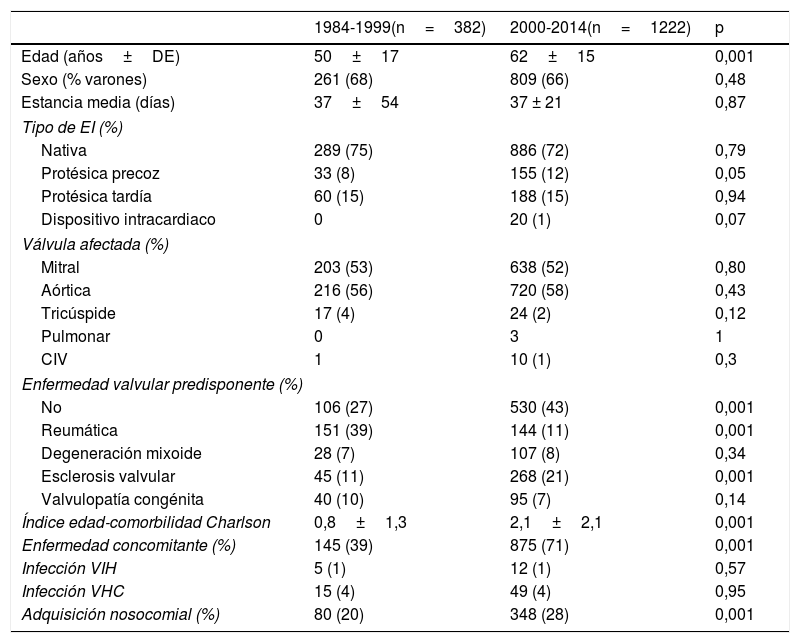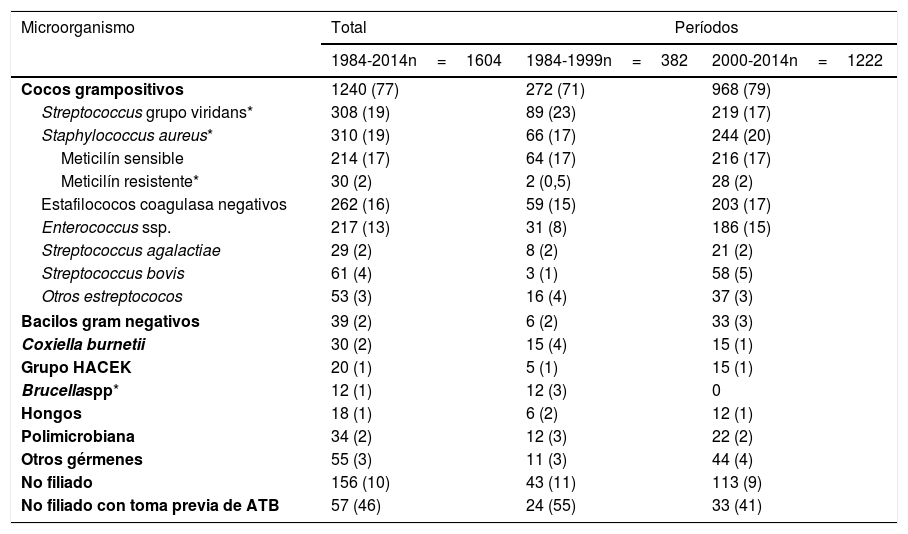Descripción de las características de las endocarditis infecciosas izquierdas con el cambio del milenio.
MétodoEstudio multicéntrico prospectivo de endocarditis izquierdas recogidas en la cohorte andaluza para el estudio de las infecciones cardiovasculares entre 1984-2014.
ResultadosDe 1.604 endocarditis recogidas 382 pertenecen al grupo 1 (período 1983-1999) y 1.222 al grupo 2 (2000-2014). Los pacientes del grupo 2 presentan mayor edad media, comorbilidad y enfermedades concomitantes, más nosocomialidad, endocarditis asociadas a la atención sanitaria y endocarditis complicadas. Se aprecia un aumento de los Staphylococcus aureus meticilín-resistentes, Enterococcus sp., bacilos gramnegativos y Streptococcus bovis. En el tratamiento aumenta el uso de cefalosporinas y desciende el de penicilina; hay más cirugía al ingreso y menos diferida. La mortalidad se sitúa alrededor del 30% en ambos milenios. En el análisis multivariante la mortalidad se asoció con: milenio anterior (grupo 1), edad, índice de Charlson, fracaso renal y shock séptico y, etiológicamente, Staphylococcus aureus.
ConclusionesLa mortalidad se mantiene estable, pese a mejoras diagnósticas y terapéuticas, debido a que los pacientes son mayores, con mayor comorbilidad, endocarditis relacionadas con la atención sanitaria/nosocomialidad y gérmenes más agresivos.
a description of infective left endocarditis at the turn of the millennium.
MethodA multicentre prospective study into the left endocarditis using data collected from the Andalusian cohort for the study of cardiovascular infections during 1984-2014.
ResultsOf the 1,604 endocarditis cases collected, 382 belonged to G1 (group-1, period 1983-1999) and 1,222 to G2 (group-2, 2000-2014). Patients in the new millennium have a significantly higher mean age, have more comorbidity and concomitant diseases, and nosocomial and health-related endocarditis are more frequent, as well as complications. An increase in methicillin-resistant Staphylococcus aureus, Enterococcus sp., Gram-negative bacilli and Streptococcus bovis was noted. Regarding treatment, there is an increase in the use of cephalosporins and a decrease in penicillins; there is more surgery when admitted to hospital and less delay. Mortality stands at around 30% in both millennia. In the multivariate analysis, mortality was associated with: previous millennium (G1), age, Charlson index, renal failure and septic shock, and aetiologically with Staphylococcus aureus.
ConclusionsMortality remains stable, despite diagnostic and therapeutic improvements, because patients are older, have greater comorbidity, a closer relationship with the health care system (nosocomial) and microorganisms are more aggressive.
Artículo
Comprando el artículo el PDF del mismo podrá ser descargado
Precio 19,34 €
Comprar ahora









